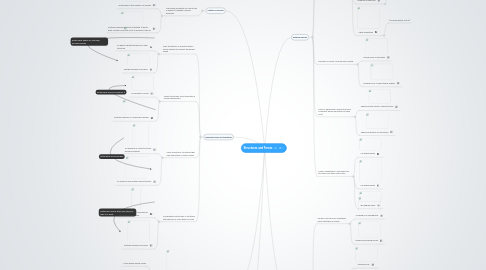
1. Purpose, Form and Function
1.1. Function: What the structure is used for
1.1.1. A cup things liquids inside
1.2. Form: What the structure looks like and how it was built
1.2.1. A computer has a rectangular shaped frame, and a clear glass screen
1.3. Purpose: What the structure was built to do
1.3.1. A ship is built to transport goods and people over bodies of water
2. Different Types of Structures
2.1. Shell Structures: A structure with a sturdy outside to support the hollow inside
2.1.1. An egg is a great example of a shell structure
2.1.2. Another example is an igloo
2.2. Frame Structures: Structures with a frame supporting it
2.2.1. An example is a bed
2.2.2. Another example is a suspension bridge
2.3. Solid Structures: Structures that have absolutely no space inside
2.3.1. An example of solid structures would be statues
2.3.2. An eraser is also another solid structure
2.4. Combination Structures: A structure that has two or more ways it is built
2.4.1. A human skeleton is a example of combination structures
2.4.2. Another example is a house
3. Loads
3.1. Dead Loads: The weight of itself caused by gravity
3.2. Live Loads: The weight of the load it's carrying
3.3. Dynamic Loads: The load that is unpredictable
4. Center Of Gravity
4.1. The center of gravity on a structure is where it`s weight is evenly balanced
4.1.1. An example is the middle of a seesaw
4.1.2. Another example would be a airplane. it has to have a center of gravity for it to balance in the air
5. Applied at the top of the structure
6. External Forces
6.1. Loads:The weight or power of the things it has to withstand or carry, the weight of gravity on the structure
6.1.1. Live Load: The weight of the objects it is meant to hold
6.1.2. Dead Load: The weight of gravity working on itself/the weight of itself
6.1.3. Dynamic Load: The weight of the unpredictable force that collides with the structure
6.2. Magnitude: How strong a force is
6.2.1. Heavy magnitude
6.2.1.1. (Wrecking ball demolishing)
6.2.2. Moderate magnitude
6.2.2.1. (Ball bouncing)
6.2.3. Light magnitude
6.2.3.1. (Flicking switch on/off)
6.3. Direction of Force: How the force works
6.3.1. Pulling force: Pulls things
6.3.2. Pushing force: Pushes things foward
6.4. Point of Application: Where the force is applied/ wehre the object or thing is hit
6.4.1. Applied at the center of the structure
6.4.2. Applied at bottom of structures
6.5. Plane of application: The angle your at before you strike a structure
6.5.1. 45 degree angle
6.5.2. 90 degree angle
6.5.3. 180 degree angle
7. Internal Forces
7.1. Tension: The force of something being stretched or pulled
7.1.1. Jumping on a divingboard
7.1.2. Rubber band being pulled
7.2. Torsion: The force of something being twisted
7.2.1. Opening a jar
7.2.2. A tornado spinning
7.3. Shear: The force of something being pulled in two separate directions
7.3.1. Scissors cutting
7.3.2. Playing tug-of-war
7.4. Compression: The force of something being pushed by it's top layer
7.4.1. Sleeping on a pillow
7.4.2. Sitting on a chair

